Our favorite homemade mashed potatoes recipe that works with skin-on and peeled potatoes. Learn which potatoes to use and how to cook them so that they are creamy and delicious. Jump to the Homemade Mashed Potatoes Recipe
Watch The Video
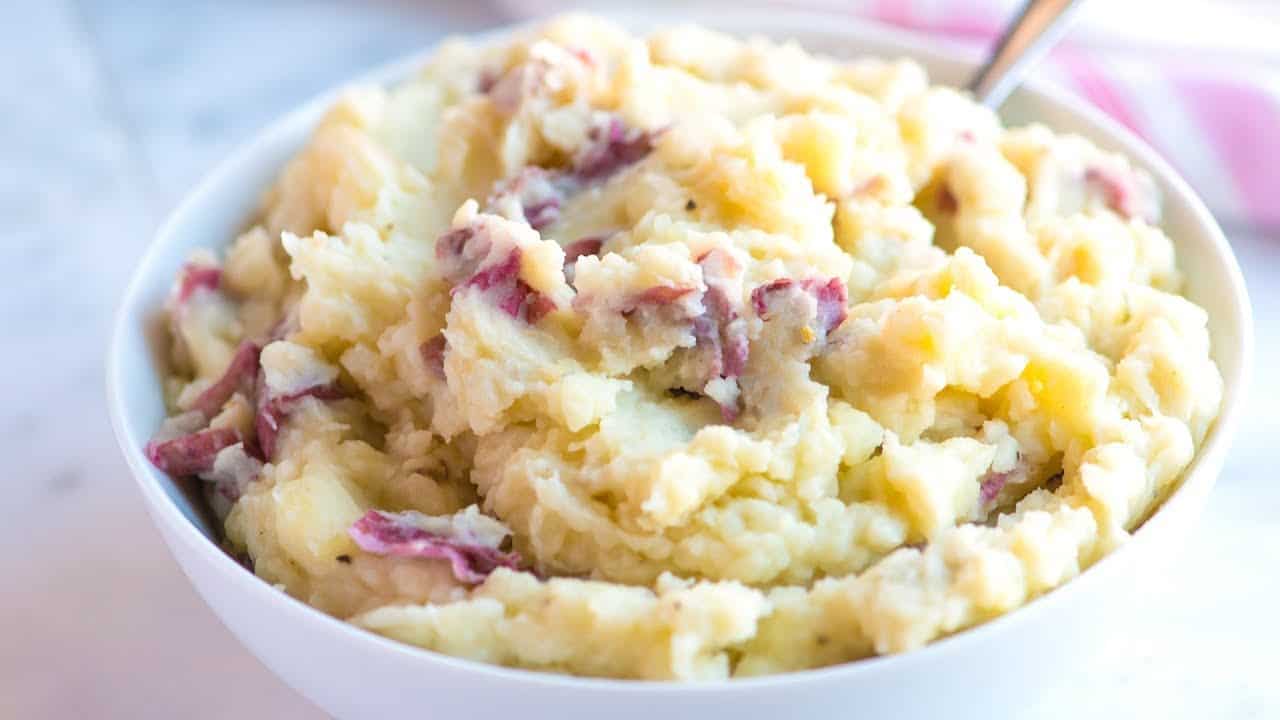
How to Make The Best Mashed Potatoes
We adore mashed potatoes and make them often. Since we make a batch almost every week, we wanted to share our favorite way to make them. The recipe varies slightly depending on who makes it. Adam likes to keep the potatoes unpeeled and I usually peel. Sometimes we use milk, sometimes we add a splash of stock (vegetable or chicken stock). And when we’re feeling feisty, we add a spoonful of sour cream or splash of cream.
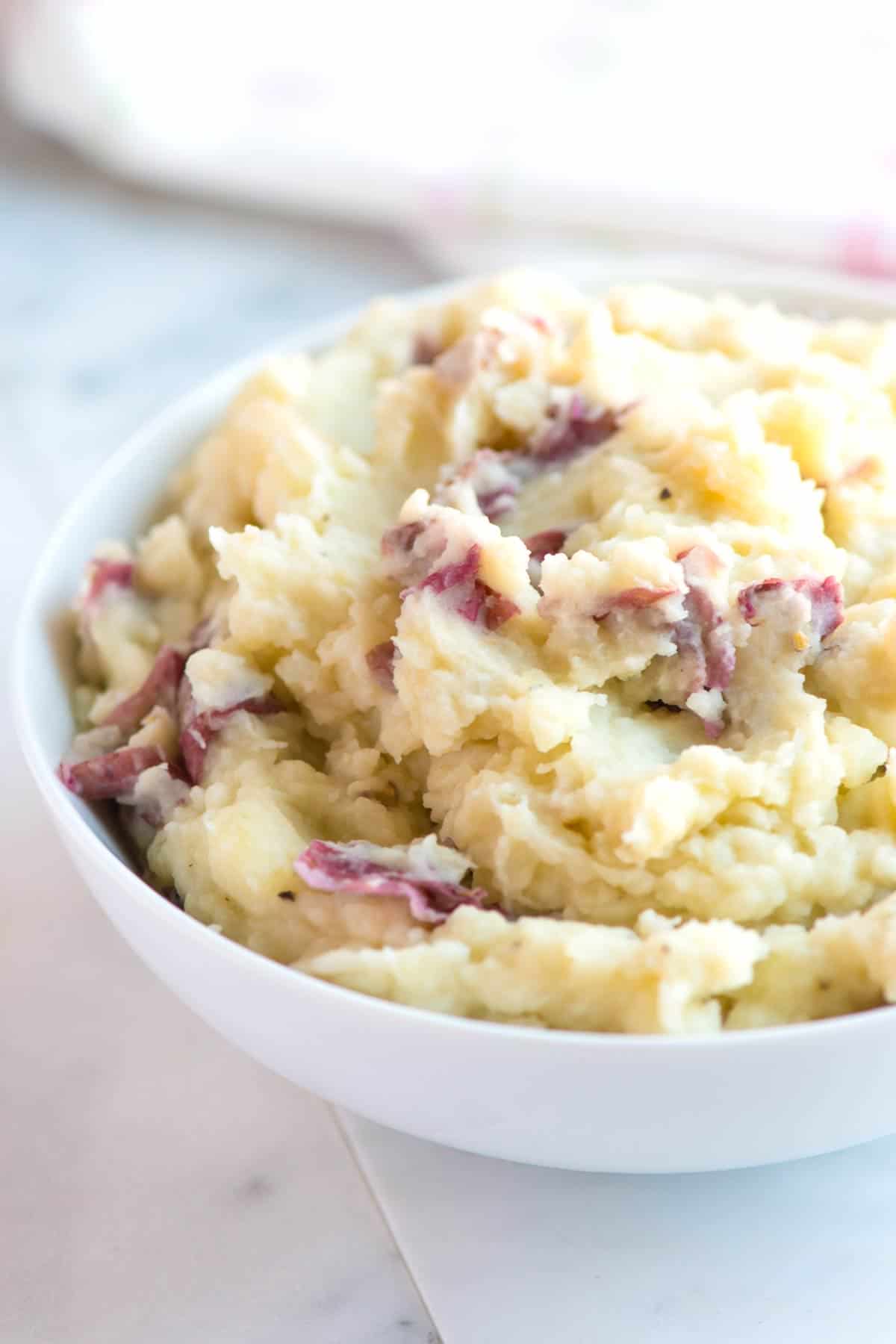
While you can think of this as an everyday recipe and one that you can adapt based on what you have in the fridge (or whoever is making it), it’s also perfect for entertaining or for holiday meals. (We always make a batch of these potatoes, our seriously good mushroom stuffing and these buttery whole roasted onions for Thanksgiving.)
What are the best potatoes to use?
I use thin-skinned potatoes like creamers (or baby potatoes) or Yukon Gold. Small yellow, white, or red potatoes are perfect. They are quick to cook and make the best skin-on mashed potatoes! We are usually short on time, so the smaller potatoes allow us to skip peeling and just slice in half or quarters. (We use the same varieties of potatoes to make this crispy oven roasted potato recipe!)
They are also creamier than more starchy potatoes, like russet potatoes. So if you love creamy mashed potatoes, choose one of the small, thin-skinned varieties.
If you love fluffy mashed potatoes, use starchy potatoes (like Russet or Idaho) or for a combination of fluffy and creamy, use both waxy potatoes (like Red Bliss or baby potatoes) and starchy potatoes.
Adam and I go back and forth about peeling the potatoes. Adam loves keeping the skins on and I prefer when the potatoes are peeled. It’s safe to say that whether or not our potatoes are peeled depends on who’s making them.
Our Best Tips For Making Mashed Potatoes
Adam and I might disagree when it comes to peeling the potatoes, but we don’t disagree when it comes to cooking them. Here are our best tips for making them in your kitchen:
Cut the potatoes into a similar size. You want the potatoes to cook evenly and keeping the potatoes a similar size helps with that. I cut mine into medium chunks (1 to 2 inches). At that size, the potatoes take about 15 minutes to cook.
Salt the cooking water. No matter what potato you choose to cook, don’t forget the salt. A tablespoon of salt should do it. Just like when you add salt to pasta water, the salty water seasons the potatoes. They won’t taste salty, only like awesome potatoes.
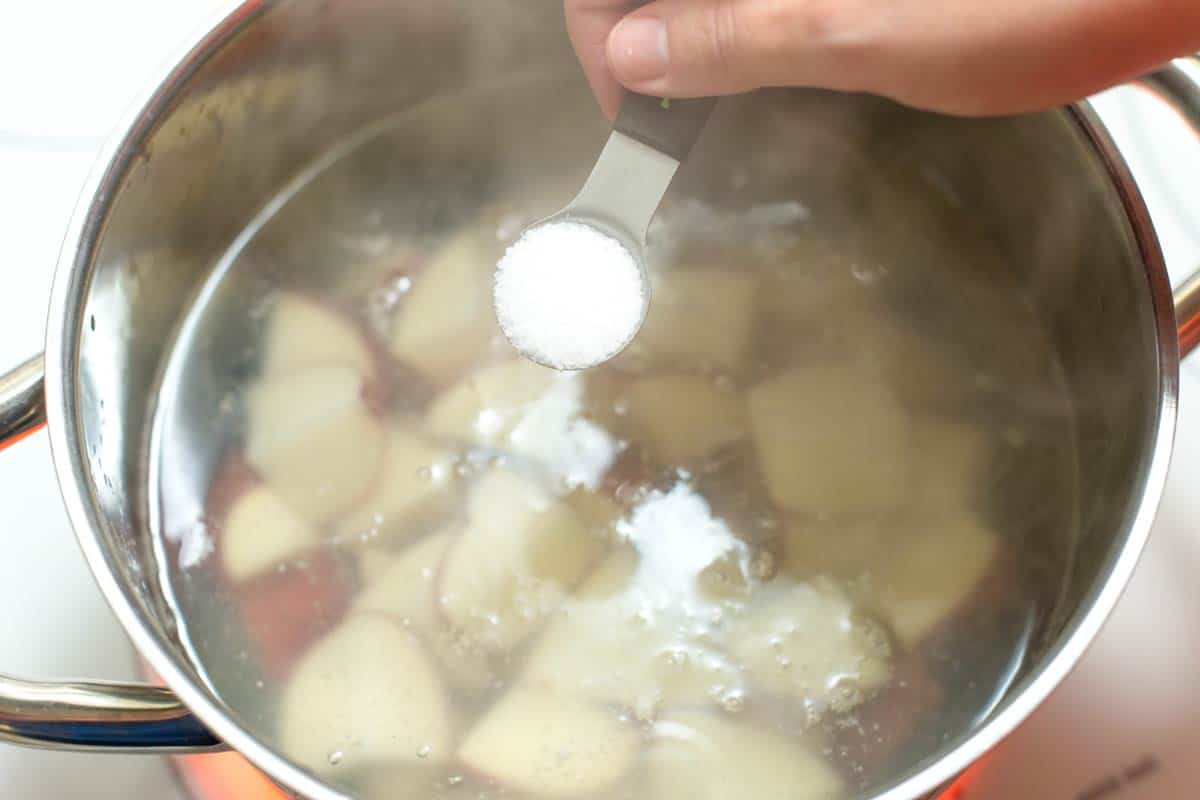
Simmer until fork tender. When I can easily pierce a potato with a fork, they are done. Cooking longer than that means that the potatoes will be overcooked, which makes them like glue.
Drain them well. Once the potatoes are done, I drain them, return them to the saucepan and cover with a clean dishtowel for about 5 minutes. This helps the potatoes absorb excess steam that can make mashed potatoes watery. Another option is to tumble the cooked potatoes onto a baking sheet and set aside for 5 minutes.
Add warm butter and milk or stock. We add some liquid and melted butter to make the potatoes extra creamy. For the liquid, we usually add equal parts of milk and chicken stock. You could add all milk or all chicken stock. You could even add a splash (or two) of cream to the potatoes to make them really creamy. Warm liquid absorbs better than cold and it keeps the mashed potatoes nice and hot.
We stick to 1 cup of liquid for 2 pounds of cooked potatoes. For stiffer mashed potatoes, reduce the amount of liquid to 3/4 cup from 1 cup.
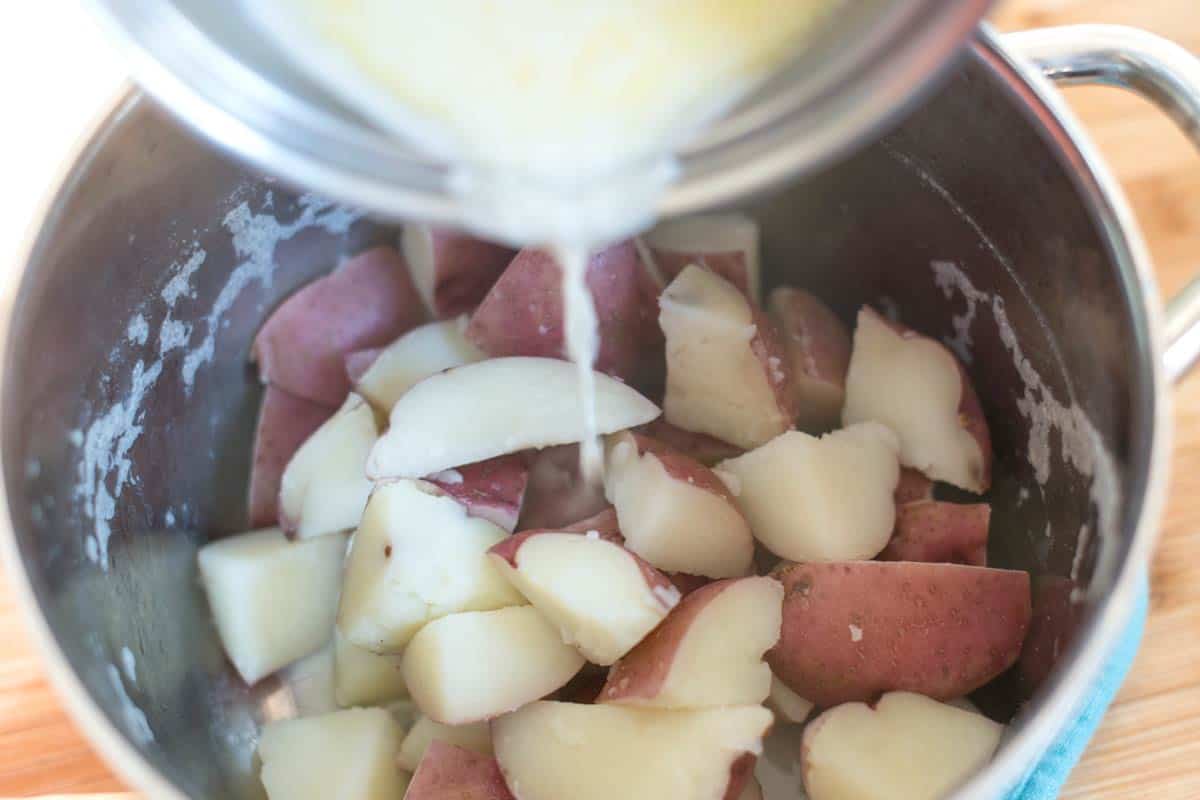
Hand Mash. Most of the time, we use our handy potato masher, but for extra creamy potatoes, use a food mill. Pass cooked potatoes through the smallest disk of a food mill then stir in milk or chicken stock and butter. (It’s best the potatoes are peeled for this). I don’t recommend using a food processor and if you use a hand blender, be careful not to over whip the potatoes since over mixing makes mashed potatoes sticky and gluey.
Make them extra creamy. When I want ultra-creamy mashed potatoes, I add a dollop of sour cream. The tanginess of sour cream cuts the richness of the butter and makes the potatoes so creamy.
Add extra flavors. You can add a variety of extra ingredients to mashed potatoes. Try garlic (fresh or roasted garlic), fresh herbs, chives, scallions, cream cheese, shredded cheese, and even cooked and crumbled bacon.
What To Serve With Mashed Potatoes
I can pretty much eat these mashed potatoes without anything else on the plate. That said, there are so many options for what to serve them with:
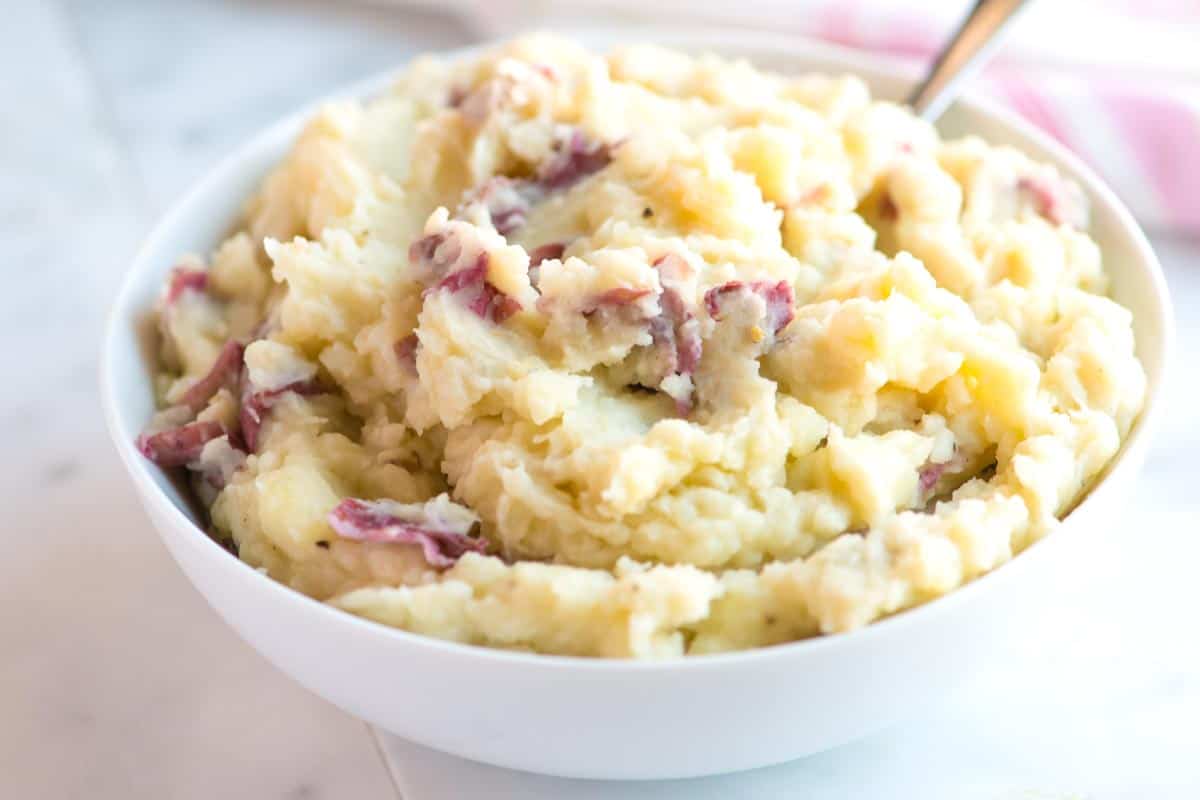
More Easy Potato Recipes
Recipe updated, originally posted November 2013. Since posting this in 2013, we have tweaked the recipe to be more clear. – Adam and Joanne
Our Favorite Homemade Mashed Potatoes
- PREP
Our favorite way to make mashed potatoes. Think of this as an everyday recipe – one that you can adapt based on what you have in the fridge. We call for 1 cup of liquid to be added to the potatoes. At home, we usually use equal parts milk to chicken stock. You could use all milk or all stock (chicken or vegetable). Or, replace some milk with heavy cream or sour cream for extra decadent potatoes. A tablespoon or two of cream cheese wouldn’t hurt, either.
The trick to great mashed potatoes is seasoning up front. Adding a hearty amount of salt to the water seasons the potatoes while they cook – we use at least 1 tablespoon. This is similar to salting pasta water.
Makes approximately 6 servings
Watch Us Make the Recipe
Directions
- Prepare Potatoes
- To Finish
Scrub then dice potatoes, making sure they are similar in size. (We often leave the skin on the potatoes, but it is completely up to you).
Drop potatoes in a large saucepan, add a tablespoon of salt and cover with water. Bring to a boil over medium-high heat then reduce to a low simmer. Cook until the potatoes fall apart when pierced with a fork, 15 to 20 minutes.
Heat the milk or chicken stock, and the butter until warm and the butter has melted. Drain then return the potatoes to the saucepan and cover with a clean dishtowel. Leave them for about 5 minutes to absorb excess steam that can make mashed potatoes watery.
Pour in the warm butter mixture then mash the potatoes until creamy. (Don’t worry if the potatoes seem a bit thin at first, they absorb the liquid after a minute or two). Stir in the pepper and splash of cream or sour cream (if using).
Taste for seasoning and adjust with additional salt and pepper. Let stand for 5 minutes so that the potatoes thicken, and then serve.
Adam and Joanne’s Tips
- You can use russet (baking) potatoes. The mashed potatoes will be a bit fluffier.
- For stiffer mashed potatoes, reduce the amount of liquid called for in the recipe to 3/4 cup from 1 cup.
- For extra creamy potatoes, use a food mill. Pass the cooked potatoes through the smallest disk of a food mill then stir in milk or chicken stock and butter. (It’s best the potatoes are peeled for this).
- Nutrition facts: The nutrition facts provided below are estimates. We have used the USDA database to calculate approximate values. We have omitted salt since you will need to add to your tastes. We assumed 1/2 milk to 1/2 stock and added a splash of cream.
If you make this recipe, snap a photo and hashtag it #inspiredtaste — We love to see your creations on Instagram and Facebook! Find us: @inspiredtaste
Nutrition Per Serving: Calories 182 / Protein 4 g / Carbohydrate 28 g / Dietary Fiber 3 g / Total Sugars 2 g / Total Fat 7 g / Saturated Fat 4 g / Cholesterol 18 mg





More Stories
Dated Kitchen Features That Homebuyers Notice
Shake the fridge Shakshuka using up leftovers
Italian Meatloaf – Once Upon a Chef